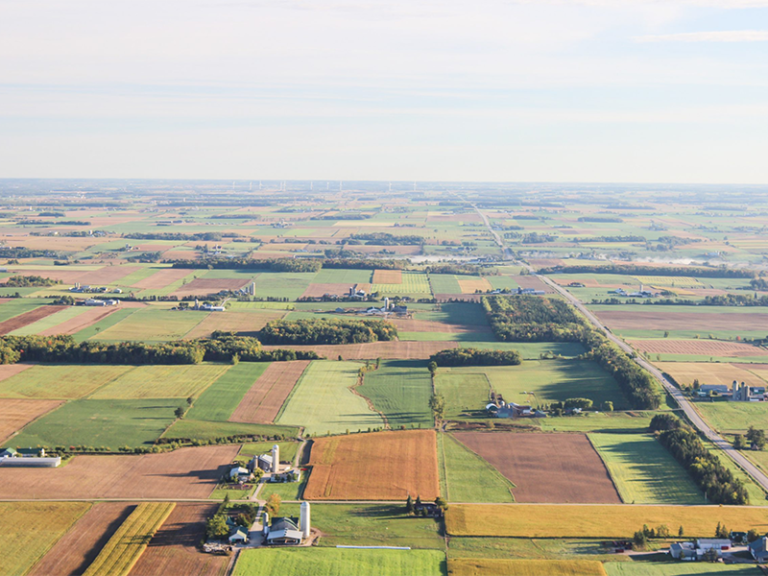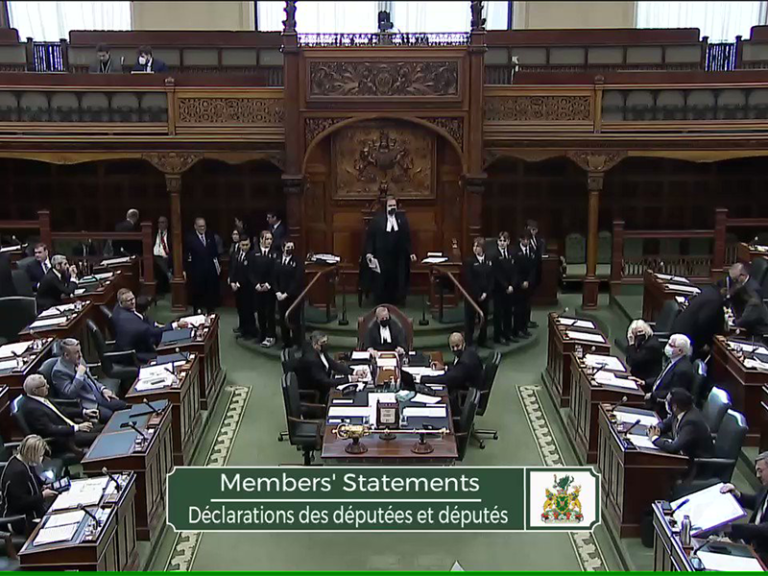First published: July 22, 2004
by Keith Oliver
This is the third in a series of articles about the process of planning for the growth and development of human settlements in general, and in particular, the 500 hectare Northeast corner of Cobourg, presently known as Area C. Thirty years from now, when Area C is fully developed, Cobourg will be twice its present size.
The idea that form follows function:
The American architect Louis Sullivan, in an article written in 1895 describing his struggle to understand the new concept of “the tall office building” (made possible by the invention of the electric motor, the elevator, and steel frame construction), presented the argument that in successful design, “form follows function”. In the design of increasingly complex buildings Sullivan was trying to find a rationale for breaking away from the importance of designing primarily for aesthetic effect.
“It is my belief that it is of the very essence of every problem that it contains and suggests its own solution… All things in nature have a form that tells us what they are, that distinguishes them from… each other, that express their inner life, their native quality… and that form is so characteristic, so recognizable, that we simply say, it is ‘natural’ that it should be so. It is the pervading law of all things organic and inorganic, of all things physical and metaphysical, of all things human and all things superhuman, of all true manifestations of the head, of the heart, of the soul, that life is recognizable in its expression when form ever follows function.” (“The Tall Office Building Artistically Considered”)
The phrase “form follows function”, expresses a design theory now practised by most architects in the design of successful buildings, and by many town planners in the successful design of the space between buildings and the form of specific human settlements.
Faced with an opportunity to shape and direct the growth of Cobourg over the next 30 years through the planning for Area C, we should not only state what the performance objectives should be for the town (seven of which I proposed in my last article), but also the form that the town as a whole should eventually achieve.
Sullivan made the argument that the most successful forms in nature are the result of satisfying the demands of the functions that the final form must satisfy. In the natural world the process of doing so takes place over thousands of years. In the industrialized modern human world change takes place in a matter of years, and the means of creating such change are extremely arbitrary in their development and application. When change happens this quickly, we must use our reason, analytical ability and foresight to identify the factors that shape form, decide what that form consists of and then plan how best to achieve it.
Planning the growth of Cobourg as a whole:
Urban planning is not new. One of the first planned cities was Miletus, Turkey, some 2400 years ago. Since then the planning of urban form has been influenced by such diverse needs as those of defence, trade, politics, religion and the ideal of achieving various kinds of utopia.
With few exceptions, the growth of human settlements in North America over the past 100 years has been most strongly influenced by the ideal of individual freedom and the unlimited individual mobility made possible by the automobile. This has happened to such an extreme that the opposite ideal of the interdependent democratic community has barely survived. The function now driving urban planning to restore a balance between the individual and community needs and to achieve environmental sustainability.
With the prospect that Cobourg will grow as much during the next 30 years as it did during the last 200 years, there is no question but that even if most of the growth takes place in Area C, a study of the performance objectives and planning objectives for the growth of that area must include planning for the town as a whole. The growth of Area C cannot help but change the form of the town as a whole.
A new land-use plan needed for all of Cobourg:
The June 10th public meeting presented a draft land-use plan for Area C without any mention of how the existing town might be effected and land-use and transportation patterns might change. In some respects one could argue that Area C is being treated as a completely separate entity from the rest of the town. To correct this the new Secondary Land-Use Plan for Area C should be part of a new Land-Use Plan fo rall of the town.
For example using transit-supportive land-use planning principles in Area C would be meaningless unless the land-use in the existing town was changed or intensified in support of public transit, and re-organized into coherent transit destinations. It would be irresponsible and wasteful to make Area C transit-supportive and not the rest of the existing town.
In another example the draft land-use plan for Area C showed two new manufacturing employment areas, one just south of a new 401 interchange at Nagle Road, and one near the South end of Brook Rd North. With the exception of a benefit to trucks destined for Lucus Point, these two areas and the new interchange need to be justified in terms of their impact on the three existing manufacturing areas, the fact they would draw heavy truck traffic through Area C, and the fact that unnecessarily easy access to the 401 would add to the possible isolation of Area C from the rest of Cobourg. An improved Elgin Street and the planned extension of Kerr Street to the eastern town boundary north of the railway tracks, would allow easy access by everyone to the three existing manufacturing employment areas. If someday more manufacturing employment area is needed it could be created south of the 401 and west of Rogers Road in the post 2034 phase of the growth of Cobourg.
Factors that will determine Cobourg’s urban form.
It would be a major mistake to develop a 30 year land-use plan for the town and not agree on the best form for the town as it grows after 2034. The factors that will determine what that form should be are; the boarders represented by the 401 Highway and Lake Ontario; the James Cockburn Conservation Area and Arboretum; the railway and its use; the location and character of the three manufacturing centres; the location and character of the five retail/service areas; the location and character of the three major recreation areas; the location of the centre-of-the-community at the Downtown; the location of the Elgin/Strathy retail area; the basic requirements of a successful public transit system; and the most appropriate direction in which the town should grow after 2034.
All things considered, and acknowledging that much more background work needs to be done, my best guess is that the most appropriate form of growth for Cobourg, after it has used up all its present lands as efficiently as possible, is not the usual concentric pattern of growth, but a linear one that stays South of the 401, avoids all the problems associated with concentric growth, and increases by one third of its 2034 size by expanding two kilometres to the east to Lovekin Road.
All of this depends on the whole town achieving the seven performance objectives, each of which will be described separately in future articles.
Planners have lost their ability to understand how land-use planning affects human function and have instead become skilled bureaucrats, making sure that planning follows the rules, the regulations and the process. The belief is that if the process is followed, the outcome will be the correct one. In trying to make a complicated planning process successful, many aspects have been quantified, value judgements have been eliminated and human values and functional needs have taken second place if not ignored altogether. The objective now is nothing more or less than a larger property tax base and more jobs. The result is a disaster in terms of quality of life.
This may be the reason why success in the development of human settlements is so often measured in terms of the growth of the property tax base and jobs. It also accounts for the continuing decline in the quality of life and the decline of community.
————————-
It is my belief that it is of the very essence of every problem that it contains and suggests its own solution. This I believe to be natural law. Let us examine, then, carefully the elements, let us search out this contained suggestion, this essence of the problem.
Later in the text, prior to the (originally four_word) dictum summarizing that law, he put it this way:
All things in nature have a shape, that is to say, a form, an outward semblance, that tells us what they are, that distinguishes them from ourselves and from each other. __ Unfailingly in nature these shapes express the inner life, the native quality, of the animal, tree, bird, fish, that they present to us; they are so characteristic, so recognizable, that we say, simply, it is ‘natural’ it should be so. (…) Unceasingly the essence of things is taking shape in the matter of things, and this unspeakable process we call birth and growth.(…)
Eventually come the ornate, Whitmanesque passages where Sullivan formulates his dictum, the “final comprehensive formula” as he put it:
Whether it be the sweeping eagle in his flight or the open apple_blossom, the toiling work_horse, the blithe swan, the branching oak, the winding stream at its base, the drifting clouds, over all the coursing sun, form ever follows function, and this is the law. (…) It is the pervading law of all things organic and inorganic, of all things physical and metaphysical, of all things human and all things superhuman, of all true manifestations of the head, of the heart, of the soul, that life is recognizable in its expression, that form ever follows function. This is the law. __ Shall we, then, daily violate this law in our art? Are we so decadent, so imbecile, so utterly weak of eyesight, that we cannot perceive this truth so simple, so very simple? (…) Is it really then, a very marvelous thing, or is it rather so commonplace, so everyday, so near a thing to us, that we cannot perceive that the shape, form, outward expression, design or whatever we may choose, of the tall office building should in the very nature of things follow the functions of the building (…)? (25)
Note: Part 3


